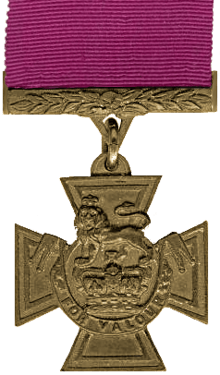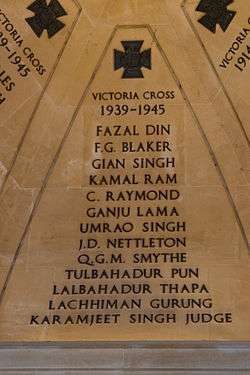Kamal Ram
| Sepoy Kamal Ram Gurjar | |
|---|---|
 | |
| Born |
17 December 1924 Bholupura village, Karauli district, Rajasthan, India |
| Died |
1 July 1982 (aged 57) Bholupura village |
| Allegiance | British India |
| Service/branch | British Indian Army |
| Rank | Honorary Major |
| Unit | 3rd Battalion 8th Punjab Regiment |
| Battles/wars | |
| Awards | Victoria Cross |
Sepoy Kamal Ram VC (17 December 1924 – 1 July 1982) was an Indian recipient of the Victoria Cross, the highest and most prestigious award for gallantry in the face of the enemy that can be awarded to British and Commonwealth forces. He was the second-youngest Indian recipient of the award.
Details
Kamal Ram Gurjar was born into a Gurjar family on 17 December 1924, at Bindapura Bholupura village of Karauli District, Rajasthan, India.[1] His father's name was Shiv Chand Gurjar.[2]
During World War II, he served in the 3rd Battalion, 8th Punjab Regiment, British Indian Army (now the 3rd Battalion, Baloch Regiment, Pakistan Army). He was 19 years old, with the rank of Sepoy, when, on 12 May 1944, his battalion assaulted the formidable German defences of the Gustav Line, across the River Gari in Italy; and he performed the deeds for which he was awarded the VC.[3] King George VI presented him with the medal in Italy in 1944.[4] He later rose to the rank of Subedar. He died in 1982.
The citation reads as follows:
The KING has been graciously pleased to approve the award of the VICTORIA CROSS to:–No. 35408 Sepoy Kamal Ram, 8th Punjab Regiment, Indian Army.
In Italy, on 12 May 1944, after crossing the River Gari overnight, the Company advance was held up by heavy machine-gun fire from four posts on the front and flanks. As the capture of the position was essential to secure the bridgehead, the Company Commander called for a volunteer to get round the rear of the right post and silence it. Volunteering at once and crawling forward through the wire to a flank, Sepoy Kamal Ram attacked the post single handed and shot the first machine-gunner; a second German tried to seize his weapon but Sepoy Kamal Ram killed him with the bayonet, and then shot a German officer who, appearing from the trench with his pistol, was about to fire. Sepoy Kamal Ram, still alone, at once went on to attack the second machine-gun post which was continuing to hold up the advance, and after shooting one machine-gunner, he threw a grenade and the remaining enemy surrendered. Seeing a Havildar making a reconnaissance for an attack on the third post, Sepoy Kamal Ram joined him, and, having first covered his companion, went in and completed the destruction of this post. By his courage, initiative and disregard for personal risk, Sepoy Kamal Ram enabled his Company to charge and secure the ground vital to the establishment of the bridgehead and the completion of work on two bridges. When a platoon, pushed further forward to widen the position, was fired on from a house, Sepoy Kamal Ram, dashing towards the house, shot one German in a slit trench and captured two more. His sustained and outstanding bravery unquestionably saved a difficult situation at a critical period of the battle and enabled his Battalion to attain the essential part of their objective.
— London Gazette, 27 July 1944.[5]
The Medal
His VC is on display in the Lord Ashcroft Gallery at the Imperial War Museum, London.

References
- ↑ "Sepoy Kamal Ram, Victoria Cross (VC) (1924-1982)".
- ↑ devendra Singh gurjar (1972). Tradition never dies: the genesis and growth of the Indian army. Lalvani Pub. House. p. 84.
In this operation Kamal Ram a Gujjar soldier of the 3/8 Punjabis won the Victoria Cross for heroism. The Cassino position crumbled, and the Allies were in possession of the Gustav defences by 17 May 1944.
- ↑ Ahmad, Maj Rifat Nadeem, and Ahmed, Maj Gen Rafiuddin. (2006). Unfaded Glory: The 8th Punjab Regiment 1798-1956. Abbottabad: The Baloch Regimental Centre. p. 280.
- ↑ "Sepoy Kamal Ram VC". nationalarchives.gov.uk. Retrieved 26 October 2014.
- ↑ The London Gazette: (Supplement) no. 36627. p. 3501. 27 July 1944. Retrieved 26 October 2014.